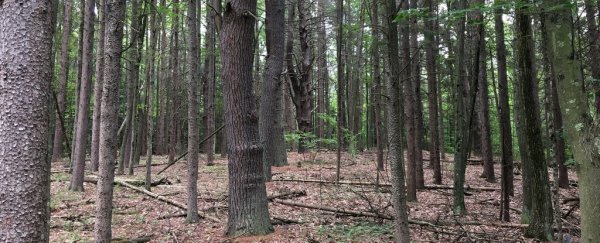There's a forest in Massachusetts that for nearly 30 years has hosted the world's longest running soil-warming experiment, measuring how hotter temperatures impact the tiny life-forms that live in the dirt.
With the way climate change is going, you could say the future itself is buried in that heated dirt. But our unknown tomorrows aren't all that's hiding there.
In this oversized outdoor research laboratory, scientists have made an unexpected discovery, finding 16 rare 'giant' viruses that are completely new to science.
"We were not looking for giant viruses," says biologist Jeff Blanchard from the University of Massachusetts Amherst (UMass).
"Our goal was to isolate bacteria directly from the environment to understand how microbial communities are changing in response to soil warming."
 (UMass Amherst/Jeff Blanchard)
(UMass Amherst/Jeff Blanchard)
Once upon a time, when soil warming wasn't perhaps quite as crucial a phenomenon to understand as it is today, scientists thought all viruses were incredibly small things, much smaller than bacteria.
And because viruses appeared to be fundamentally unlike the three 'domains of life' – bacteria, archaea, and eukaryota – there was doubt whether they were, technically, alive.
In more recent times, however, the discovery of giant viruses has challenged some of these scientific concepts, with researchers finding unknown viral strains that inhabit much larger physical forms (rivalling bacteria) and with much larger and more complex genomes too.
These giant viruses were only discovered this century, and up until now they've usually been found in aquatic habitats.
For that reason alone the Harvard Forest discovery is remarkable, as this represents the first time giant viruses have been discovered in a terrestrial ecosystem, and all from a single clump of dirt.
"The metagenomic data generated here from a single sampling site contained far more new giant virus genomes than any other data set I have seen to date," says one of the team, bioinformaticist Frederik Schulz from the Department of Energy's Joint Genome Institute (JGI).
"We recovered 16 distinct giant virus genomes in this study, but we are merely scratching the surface. If we sample more at the same site this number would easily double, triple, or even quadruple."
To identify the microbes, the researchers suspended them in a solution containing a non-toxic dye that binds to DNA, and used a technique called fluorescence-activated cell sorting (FACS) to isolate individual cells.
An additional method, known as mini-metagenomics, helped the team to sequence the DNA of approximately 2,000 individual cells, which ultimately yielded the discovery of the 16 giant viruses unknown to science before now.
According to the researchers, the approach could make it easier than ever to identify viruses in the soil metagenome in the future.
But already it's expanded our genetic understanding of these microbes, increasing our records of total giant virus phylogenetic diversity by more than 20 percent, and uncovering some of the largest viruses discovered to date.
"Soil is immensely diverse," says one of the UMass researchers, Lauren Alteio, "and we are only beginning to scratch the surface of the organisms and viruses that inhabit it."
The findings are reported in Nature Communications.
